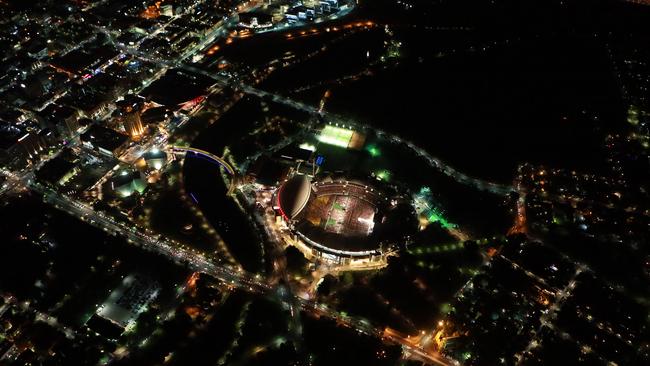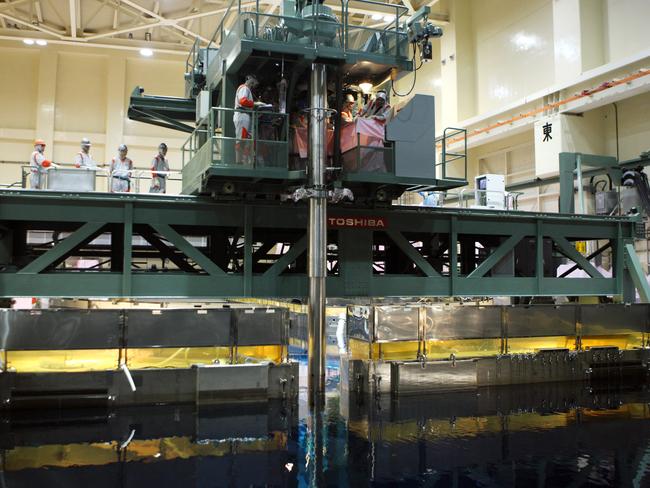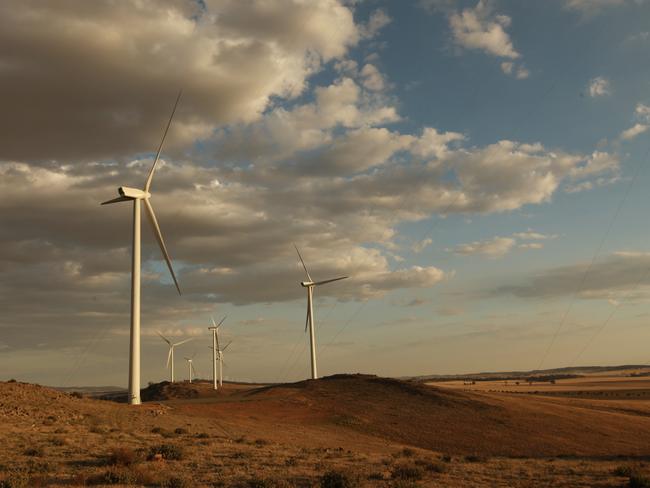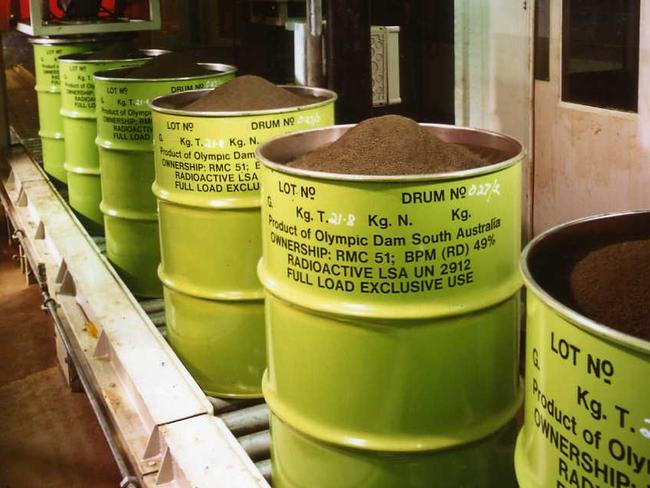Is building a nuclear waste dump in Australia really the best idea?
THINGS are so grim in one Australian state that its leaders are scrambling for answers. What they’re proposing is risky.

THINGS are looking grim for the South Australian economy, and everyone is trying to think of ways to kickstart growth. But is building a nuclear waste dump really the best idea?
South Australia has the worst unemployment rate in Australia, which hit 7.6 per cent in May, the highest since 2001. New figures out today showed it grew to 8.2 per cent in June.
University of Adelaide Associate Professor John Spoehr told The Advertiser the state was “on a pathway to double digit unemployment in the absence of major new investment in infrastructure and construction projects”.
In this atmosphere Liberal senator for South Australia Sean Edwards has floated his ambitious new plan for a nuclear power plant and waste storage that promises economic growth and which could potentially see state taxes abolished and free electricity for residents.
In February a poll for The Advertiser revealed 58.3 per cent of its readers were supportive of building a nuclear power plant in the state. Now state Labor Premier Jay Weatherill, who has acknowledged that the state is in transition with some industries in decline, has formed a Royal Commission to look into the idea.
Money does talk, and Senator Edwards believes nuclear could be an “economic game changer”. So is he right? Here’s everything you need to know about this radical proposal.
THE LURE OF FREE ELECTRICITY
Liberal senator for South Australia Sean Edwards has become the cheerleader for nuclear, delivering a speech in April that called for a major rethink.
He described nuclear as a “once in a lifetime opportunity” and said he had been developing a business case for South Australia becoming a player in the global spent nuclear fuel recycling industry.
The global stockpile of spent uranium stands at around 240,000 tonnes, and Senator Edwards said some countries could be willing to pay up to $1 million a tonne to send used fuel rods to South Australia for storage.
He said he had already lined up a “prospective client state”, which had indicated it would be willing to pay for the costs of building a nuclear facility in Australia, if it was built to cater to them.
Senator Edwards also dangled the possibility of cheap energy for residents if the nuclear waste could be recycled to produce either low or no-cost electricity. He said some countries were legally, politically or technically restricted from reprocessing their waste even if they wanted to.
Senator Edwards told news.com.au if a sodium cooled fast reactor was built using Generation IV technology, “pyro processing” could see spent fuel rods collected from nuclear facilities around the world and recycled so more energy can be squeezed out of them. This could generate free to low-cost energy for South Australians.

“At the core of any successful economy is low energy cost, that’s how to turn the economy in South Australia around, to get industries coming back and at least focusing on South Australia as an option,” Senator Edwards said.
“You might also imagine the economic impact of abundant cheap power on employment, on consumer spending, on disposable income, on business investment and on state domestic product.”
But at least one expert believes the scenario is too good to be true, and would do little to help the state’s economy in the short to medium term. The technology Senator Edwards has suggested is still in development and will not be feasible for more than 20 years.
Retired researcher Richard Leaver, formerly of Flinders University, told news.com.au that no Generation IV reactors had yet been built. These reactors are not generally expected to be available for commercial construction before 2030-40.
“And sodium cooling has, so far, a four-decade history of failure and serious accident,” Mr Leaver said.

He said the state government should wait until someone managed to get the reactor working on an industrial scale before accepting anyone’s spent nuclear fuel.
Even if researchers could develop a Generation IV generator as a working technology, this would likely reduce the potential economic benefits.
“If a Generation IV reactor could be built then there would not be any need to bring the irradiated fuel to South Australia for reprocessing, as this fuel could be used to burn and generate power in a Generation IV reactor so why would any country want to get rid of it?” Mr Leaver said.
Mr Leaver said spent fuel would become more valuable and the new technology would also mean that countries would not need to buy more uranium, as they could just reprocess their own stockpiles of used fuel for energy.
Commissioner Kevin Scarce, who is leading a royal commission investigation into the viability of nuclear energy in South Australia, agrees that Generation IV reactors are not yet viable.
Commissioner Scarce has just returned from a trip overseas to inspect nuclear facilities in Taiwan, Japan, Finland, Austria, France and the United Kingdom.
During an interview on ABC Adelaide, he said Generation IV reactors would be a lot safer but the challenge was understanding when they might be commercially available.
The research group looked at sodium cooled reactors in particular and Commissioner Scarce said: “I certainly wouldn’t think based on what we’ve seen to date that they’ll be available much before 2040”.
Senator Edwards had previously acknowledged that it would take time to develop a regulatory framework, to carry out all necessary studies, to pass relevant legislation and to construct the necessary facilities. He described this as taking “no less than five years”.
YOU SNOOZE, YOU LOSE
If it did take more than 25 years to build a nuclear power plant then the technology could be made obsolete by renewables.
Associate Professor Mark Diesendorf, deputy director of the Institute for Environmental Studies, University of New South Wales said that technology for renewable energy had advanced so quickly it was now possible to run the entire national electricity network using these energy sources.
“There is no need for nuclear energy for South Australia or Australia as a whole,” Prof Diesendorf said during a CRC CARE workshop held on June 16 to discuss Australia’s nuclear future.

One of the reasons why there will be continuing job losses in South Australia is due to the closure of the Port Augusta power stations and Leigh Creek coal mine by 2018, which will see about 440 jobs lost.
The closures are partly being blamed on the rise of renewable energy sources and an oversupply in the National Electricity Market, which SA Manufacturing Minister Kyam Maher has described as holding more capacity than is needed to meet demand.
Last October, South Australia managed for the first time to get more than 100 per cent of its electricity needs for a working day between 9.30am to 6pm, from a combination of wind and solar energy. Overall it gets more than 30 per cent of its power from renewables, and has a target of 50 per cent to be achieved within 10 years.
Prof Diesendorf said it would only take 15 to 20 years to go to 100 per cent renewables in the state.
“We can now say that a scenario involving a mix of renewable energy sources would be less expensive, and emit less carbon dioxide emissions over its life cycle than a nuclear plus fossil (fuel) scenario,” Prof Diesendorf said.
He said nuclear would also be the worst possible partner for renewable energy systems in South Australia because nuclear energy was much less flexible in its operation so it would be difficult for it to match variations in wind and sun.
“Peak load stations need matching, not base load stations. Nuclear is too large. and smaller (nuclear plants) are a long way from being on market,” he said.
BUT WHO’S GOING TO PAY?
Alinta Energy has investigated building a solar thermal plant at the Port Augusta site and said it was technically feasible.
But this year it abandoned its plans because it found the plant was not economically viable as it would cost close to $800 million to build.
However its plans were also impacted by a $150 million expansion plan from Sundrop Farms, including a solar project to power a greenhouse facility supported by a $6 million state government grant.
Ben Heard, doctoral candidate at the University of Adelaide, told the CRC CARE workshop that his modelling found solar thermal was more expensive in terms of capital cost ($11.4 billion) than nuclear ($3.5-$4.8 billion). However, wind was the cheapest to build ($1.4 billion).
He also made the point that the operational life for solar and wind infrastructure was about 25 years. In contrast, a nuclear power plant lasted about 60 years.
Senator Edwards pointed out how expensive renewables were, compared to his plan for a reactor, which would ideally be funded by money that other countries would pay Australia to take their waste.
“The cost of a renewable energy job to a taxpayer in Australia is $200,000. That is the subsidy each renewable energy job attracts,” Senator Edwards said.
SHOW ME THE MONEY
Regardless of whether there was money to build a nuclear power station and enough demand to sustain it in South Australia, taking other countries’ waste could still bring in big dollars to the struggling state. And some suspect this could actually be the point.
“The global enrichment market is oversaturated, and no-one credibly believes nuclear power is a realistic proposition for the sparse South Australian grid,” Greens senator Scott Ludlam argued in a column for New Matilda.
“That leaves only the probability that this whole exercise is designed to build the case for a national or international radioactive waste dump.”

Doctoral candidate Ben Heard said waste would be stored in a concrete building. A potential nuclear power plant would generate about 6250 tonnes of spent fuel in its 60 year life. This would generally need to be stored in a 9500m2 area.
Senator Edwards said some countries could be willing to pay up to $1 million a tonne to send used fuel rods to South Australia for storage.
Retired researcher Richard Leaver agreed there probably was a market for the waste but was unsure whether it would be that lucrative.
“On the nuclear front (Senator Edwards) has said that there’s so much money in this that state taxes can be done away with, and that the power created would be virtually free. I see no evidence for any of this, and he certainly hasn’t provided any.”
IS IT SAFE?
Mr Heard said that nuclear was among the safest energy supply services in the world.
“We’ve had 15,500 reactor years of operation and three accidents that anyone can name,” he told the CRC CARE workshop.
He said that the impacts of these accidents had also been overstated. For example, a United Nations report on the accident in Fukushima, Japan found no radiation-related deaths or acute diseases had been identified among the workers or the public.
The report also suggested it did not expect there were be a noticeable increase in cancer for adults living in Fukushima.
“So it really comes down to gaining people’s trust,” Mr Heard said.
RELATED: Pacific island leaking radiation
But Associate Professor Mark Diesendorf said the real impacts of the Fukushima accident could not be known after just four years. He said it would take decades for the impact to be seen and this was also difficult to assess because it was hard to determine whether cancer was caused by radiation or something else.
Research from the International Agency for Research on Cancer also estimated that radiation from the accident at Chernobyl in the Ukraine, could cause 41,000 cases of cancer.
“The claim that nuclear is one of the safest just doesn’t stand up to scientific scrutiny,” Prof Diesendor said. “It’s also based on the notion that accidents ... should be ignored when their impact are enormous.”
Commissioner Kevin Scarce visited Fukushima and said seeing the abandoned cities made the group really keen to understand what went wrong.
“It certainly makes you open your eyes and (want to get) the safety aspects right,” Commissioner Scarce said.
He said that the reactor’s position just four metres above sea level, in a very unstable geological region right on the water, made “you wonder what sort of planning went into that design”.
The relationship between the regulator and the operator also seemed to have broken down and Commissioner Scarce said there had been “complacency all round, by their own omission”.
Some could argue that creating a nuclear waste dump would also make Australia a target for those wanting to access plutonium for nuclear weapons, but Mr Leaver said this was probably unlikely.
He did agree however, that reprocessing nuclear fuel was a proliferation concern, which is why the Americans banned domestic reprocessing in the 1970s.
When uranium is processed into fuel, it produces plutonium, which can be used in nuclear weapons and nuclear reactors.

When asked whether this could actually make Australia a target for those trying to arm nuclear weapons, Sen Edwards said he did not think so.
“We are geopolitically isolated and geologically sound, we can handle this stuff,” Senator Edwards said.
“We would do the world a favour by taking this waste away, we are actually reducing the global proliferation risk.”
NEXT STEPS
Senator Edwards told news.com.au that he would be putting forward a proposal for a nuclear power plant to the Royal Commission by July 24.
The Nuclear Fuel Cycle Royal Commission has been sent up to undertake an independent and comprehensive investigation into the potential for the expansion of exploration and extraction of minerals in South Australia, the undertaking of further processing of minerals and manufacture of materials containing radioactive substances, the use of nuclear fuels for electricity generation and the storage and disposal of radioactive and nuclear waste.
The closing date for submissions on two of its issues papers is July 24. It is due to deliver its final report in May 2016.



